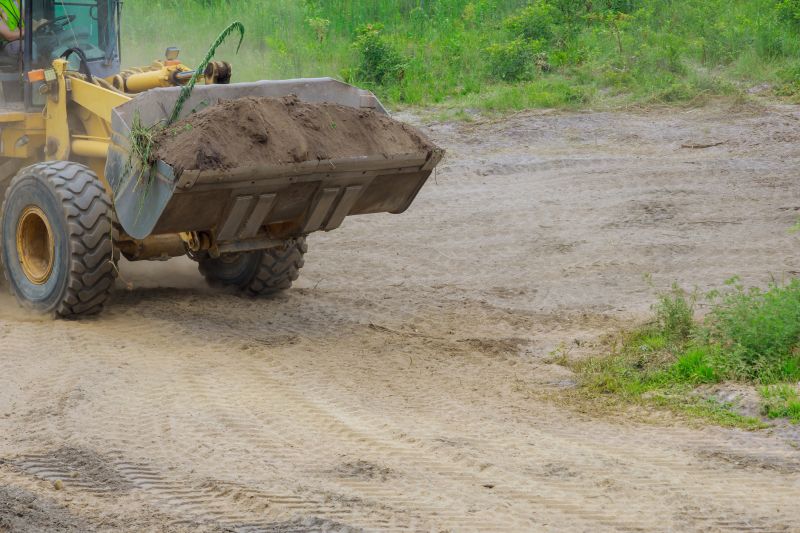Expert Picks for Ground Leveling Equipment and Supplies
Find out which products professionals rely on for efficient ground preparation and leveling tasks.
 Ground levelings are essential for creating smooth, even surfaces in a variety of outdoor projects, including landscaping, paving, and construction. Achieving a level foundation can improve the durability and appearance of walkways, patios, and driveways. The selection of appropriate products for ground leveling depends on factors such as the type of surface, the extent of unevenness, and the specific project requirements. From hand tools to power equipment, there are numerous options designed to facilitate efficient and effective leveling.
Ground levelings are essential for creating smooth, even surfaces in a variety of outdoor projects, including landscaping, paving, and construction. Achieving a level foundation can improve the durability and appearance of walkways, patios, and driveways. The selection of appropriate products for ground leveling depends on factors such as the type of surface, the extent of unevenness, and the specific project requirements. From hand tools to power equipment, there are numerous options designed to facilitate efficient and effective leveling.
Top Overall Option
Multi-Functional Ground Leveling Tool Set
A versatile set that includes various hand tools such as rakes, screeds, and tampers designed for detailed ground leveling and surface preparation. This comprehensive collection allows for precise adjustments and is suitable for small to medium projects, offering durability and ease of use for both DIYers and professionals.
Types of Products For Ground Levelings
Hand Rakes
Ideal for spreading and smoothing soil, gravel, or sand in small to medium areas.
Screeds and Straightedges
Used to level surfaces by screeding over loose material to achieve a flat, even finish.
Tampers and Plate Compactors
Mechanized tools that compact soil and gravel, providing stability and preventing future shifting.
Leveling Bars
Long, straight tools used to check and adjust surface evenness across large areas.
Vibratory Rollers
Heavy machinery used for large-scale compaction of soil and aggregate materials.
Soil Stabilizers
Products designed to improve soil cohesion and stability before leveling.
Sand Spreaders
Tools for evenly distributing sand or fine aggregate across surfaces.
Gravel Leveling Boards
Flat boards used to spread and smooth gravel layers for even distribution.
Water-filled Rollers
Lightweight rollers filled with water to assist in gentle compaction and surface smoothing.
Plastic Leveling Guides
Adjustable guides to help maintain consistent height and slope during leveling.
Concrete Trowels
Tools used for finishing and smoothing concrete surfaces after leveling.
Laser Levels
Electronic devices that project level lines to assist in precise surface alignment.
Compaction Mats
Pads that help distribute pressure evenly during manual or small-scale compaction tasks.
Wheel Barrows
Essential for transporting soil, gravel, or other materials during leveling projects.
Vibrating Hand Tools
Small vibratory tools for detailed surface adjustments and small-area compaction.
Popular Choices
A fundamental tool for spreading and smoothing loose materials in small projects.
A simple, long straightedge used to level surfaces manually across various substrates.
A commonly used machine for soil and gravel compaction in larger projects.
Ideal for finishing concrete surfaces after initial leveling and smoothing.
Popular electronic tool for ensuring precise level lines during surface preparation.
Widely used for improving soil cohesion before leveling and compacting.
Useful for evenly distributing gravel over large areas with minimal effort.
Lightweight and easy to maneuver, suitable for small to medium surface smoothing tasks.
Simple tools for marking and checking height levels across a site.
Popular for transporting materials efficiently during ground leveling projects.
Compact machine for spot compaction and surface finishing in tight spaces.
Commonly used for finishing concrete surfaces after initial leveling.
Handy device for projecting level lines over large areas for accurate surface alignment.
Helps loosen and prepare soil before leveling, especially in gardening or landscaping.
Understanding the different types of ground leveling products can help users make informed decisions. Hand tools like rakes and screeds are suitable for small-scale adjustments and detailed work, while larger projects may require mechanized equipment such as plate compactors or power screeds. Proper preparation, including soil assessment and moisture control, enhances the effectiveness of these tools. Additionally, using the right leveling products can reduce labor time and improve safety during the process.
It's important to consider the material compatibility of leveling products, whether working with soil, gravel, sand, or other substrates. Durability and ease of use are also key factors, especially for tools that will see frequent or heavy-duty use. Investing in quality products can lead to better results and longer-lasting surfaces. Whether you are a DIY enthusiast or a professional contractor, selecting the appropriate ground leveling tools and supplies is crucial for achieving a stable, level foundation for your project.
Key Buying Considerations
- Determine the scale of your project to select appropriately sized tools and equipment.
- Assess the type of material you'll be working with, such as soil, gravel, or sand.
- Consider whether manual tools or mechanized equipment best suits your needs and budget.
- Evaluate the durability and build quality of tools, especially if they will see frequent use.
- Check for ergonomic features to reduce fatigue during extended use.
- Look for versatile products that can handle multiple tasks, increasing value.
- Ensure compatibility with existing equipment or accessories you may already own.
- Review user ratings and feedback for insights into performance and reliability.
- Consider ease of transportation and storage, especially for larger machinery.
- Identify any maintenance requirements or costs associated with the products.
- Think about safety features and ease of operation to prevent accidents.
- Verify whether the tools are suitable for outdoor conditions and weather resistance.
- Determine if additional accessories or attachments are available for expanded use.
- Compare warranties or guarantees offered by the manufacturer for peace of mind.
- Set a realistic budget that balances quality with affordability.
This page contains affiliate links. We may earn a commission if you purchase through these links, at no additional cost to you.
